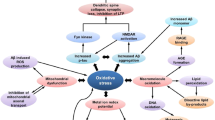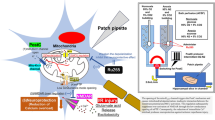Abstract
The neuroprotective effects of superoxide dismutase (SOD) against hypoxia/reperfusion (I/R) injury and of humanin (HN) against toxicity by familial amyotrophic lateral sclerosis (ALS)-related mutant SOD led us to hypothesize that HN might have a role to increase the activity of SOD, which might be involved in the protective effects of HN on neuron against Alzheimer’s disease-unrelated neurotoxicities. In the present study, we found that 4 h ischemia and 24 h reperfusion induced a significant increase in lactate dehydrogenase (LDH) release, malondialdehyde (MDA) formation and the number of karyopyknotic nuclei (4′,6-diamidino-2-phenylindole dihydrochloride nuclear dyeing) and a decrease in the number of Calcein-AM-positive living cells and cell viability. Pretreatment of the cells with HN led to a significant decrease in LDH release, MDA formation and the number of karyopyknotic nuclei, and an increase in the number of Calcein-AM-positive living cells and cell viability in neurons treated with I/R. We also found a significant decrease in SOD activity in neurons treated with I/R only, while pre-treatment with HN before I/R induced a significant increase in the activity of SOD as compared with the I/R group. Our findings implied that HN protects cortical neurons from I/R injury by the increased SOD activity and that the protective effect of HN on neurons against I/R is concentration-dependent.



Similar content being viewed by others
References
Arakawa T, Kita Y, Niikura T (2008) A rescue factor for Alzheimer’s diseases: discovery, activity, structure, and mechanism. Curr Med Chem 15:2086–2098
Avrova NF, Victorov IV, Tyurin VA, Zakharova IO, Sokolova TV, Andreeva NA, Stelmaschuk EV, Tyurina YY, Gonchar VS (1998) Inhibition of glutamate-induced intensification of free radical reactions by gangliosides: possible role in their protective effect in rat cerebellar granule cells and brain synaptosomes. Neurochem Res 23:945–952
Chan PH, Kawase M, Murakami K, Chen SF, Li Y, Calagui B, Reola L, Carlson E, Epstein CJ (1998) Overexpression of SOD1 in transgenic rats protects vulnerable neurons against ischemic damage after global cerebral ischemia and reperfusion. J Neurosci 18:8292–8299
Chiba T, Yamada M, Sasabe J, Terashita K, Aiso S, Matsuoka M, Nishimoto I (2006) Colivelin prolongs survival of an ALS model mouse. Biochem Biophys Res Commun 343:793–798
Chiba T, Yamada M, Aiso S (2009) Targeting the JAK2/STAT3 axis in Alzheimer’s disease. Expert Opin Ther Targets 13:1155–1167
Deguchi K, Hayashi T, Nagotan S, Sehara Y, Zhang H, Tsuchiya A, Ohta Y, Tomiyama K, Morimoto N, Miyazaki M, Huh NH, Nakao A, Kamiya T, Abe K (2008) Reduction of cerebral infarction in rats by biliverdin associated with amelioration of oxidative stress. Brain Res 1188:1–8
Du F, Qian ZM, Zhu L, Wu XM, Yung WH, Tsim T, Ke Y (2009) L-DOPA neurotoxicity is mediated by up-regulation of DMT12IRE expression. PLoS One 4:e4593
Esposito E, Cuzzocrea S (2009) Role of nitroso radicals as drug targets in circulatory shock. Br J Pharmacol 157:494–508
Fang D, Li Z, Zhong-ming Q, Mei WX, Ho YW, Yuan XW, Ya K (2008) Expression of bystin in reactive astrocytes induced by ischemia/reperfusion and chemical hypoxia in vitro. Biochim Biophys Acta 1782:658–663
Francis JW, Ren J, Warren L, Brown RH Jr, Finklestein SP (1997) Postischemic infusion of Cu/Zn superoxide dismutase or SOD:Tet451 reduces cerebral infarction following focal ischemia/reperfusion in rats. Exp Neurol 146:435–443
Freeman BA, Crapo JD (1982) Biology of disease: free radicals and tissue injury. Lab Invest 47:412–426
Guo B, Zhai D, Cabezas E, Welsh K, Nouraini S, Satterthwait AC, Reed JC (2003) Humanin peptide apoptosis by interfering with Bax activation. Nature 423:456–461
Hashimoto Y, Niikura T, Tajima H, Yasukawa T, Sudo H, Ito Y, Kita Y, Kawasumi M, Kouyama K, Doyu M, Sobue G, Koide T, Tsuji S, Lang J, Kurokawa K, Nishimoto I (2001) A rescue factor abolishing neuronal cell death by a wide spectrum of familial Alzheimer’s disease genes and Abeta. Proc Natl Acad Sci USA 98:6336–6341
Hashimoto Y, Ito Y, Niikura T, Shao Z, Hata M, Oyama F, Nishimoto I (2001) Mechanisms of neuroprotection by a novel rescue factor humanin from Swedish mutant amyloid precursor protein. Biochem Biophys Res Commun 283:460–468
Hashimoto Y, Niikura T, Ito Y, Sudo H, Hata M, Arakawa E, Abe Y, Kita Y, Nishimoto I (2001) Detailed characterization of neuroprotection by a rescue factor humanin against various Alzheimer’s disease-relevant insults. J Neurosci 21:9235–9245
Hashimoto Y, Suzuki H, Aiso S, Niikura T, Nishimoto I, Matsuoka M (2005) Involvement of tyrosine kinases and STAT3 in humanin-mediated neuroprotection. Life Sci 77:3092–3104
Hashimoto Y, Kurita M, Aiso S, Nishimoto I, Matsuoka M (2009) Humanin inhibits neuronal cell death by interacting with a cytokine receptor complex or complexes involving CNTF receptor alpha/WSX-1/gp130. Mol Biol Cell 20:2864–2873
He W, Qian Zhong M, Zhu L, Christopher Q, Du F, Yung WH, Ke Y (2008) Ginkgolides mimic the effects of hypoxic preconditioning to protect C6 cells against ischemic injury by up-regulation of hypoxia-inducible factor-1 alpha and erythropoietin. Int J Biochem Cell Biol 40:651–662
Jackson RM, Parish G, Ho YS (1996) Effects of hypoxia on expression of superoxide dismutases in cultured ATII cells and lung fibroblasts. Am J Physiol 271:L955–L962
Jin H, Liu T, Wang WX, Xu JH, Yang PB, Lu HX, Sun QR, Hu HT (2010) Protective effects of [Gly14]-humanin on beta-amyloid-induced PC12 cell death by preventing mitochondrial dysfunction. Neurochem Int 56(3):417–423
Kale M, Rathore N, John S, Bhatnagar D (1999) Lipid peroxidative damage on pyrethroid exposure and alterations in antioxidant status in rat erythrocytes: a possible involvement of reactive oxygen species. Toxicol Lett 105:197–205
Kariya S, Takahashi N, Ooba N, Kawahara M, Nakayama H, Ueno S (2002) Humanin inhibits cell death of serumdeprived PC12h cells. Neuroreport 13:903–907
Kariya S, Takahashi N, Hirano M, Ueno S (2003) Humanin improves impaired metabolic activity and prolongs survival of serum-deprived human lymphocytes. Mol Cell Biochem 254:83–89
Khan MM, Ahmad A, Ishrat T, Khuwaja G, Srivastawa P, Khan MB, Raza SS, Javed H, Vaibhav K, Khan A, Islam F (2009) Rutin protects the neural damage induced by transient focal ischemia in rats. Brain Res 1292:123–135
Luciano F, Zhai D, Zhu X, Bailly-Maitre B, Ricci JE, Satterthwait AC, Reed JC (2005) Cytoprotective peptide humanin binds and inhibits proapoptotic Bcl-2/Bax family protein BimEL. J Biol Chem 280:15825–15835
Matsuoka M, Hashimoto Y, Aiso S, Nishimoto I (2006) Humanin and colivelin: neuronal-death-suppressing peptides for Alzheimer’s disease and amyotrophic lateral sclerosis. CNS Drug Rev 12:113–122
Matsuoka M (2009) Humanin; a defender against Alzheimer’s disease? Recent Pat CNS Drug Discov 4:37–42
Matsuoka M, Hashimoto YM (2010) Humanin and the receptors for humanin. Mol Neurobiol 41:22–28
Murphy JG, Smith TW, Marsh JD (1988) Mechanisms of reoxygenation-induced calcium overload in cultured chick embryo heart cells. Am J Physiol 254:H1133–H1141
Muzumdar RH, Huffman DM, Atzmon G, Buettner C, Cobb LJ, Fishman S, Budagov T, Cui L, Einstein FH, Poduval A, Hwang D, Barzilai N, Cohen P (2009) Humanin: a novel central regulator of peripheral insulin action. PLoS One 4:e6334
Niikura T, Tajima H, Kita Y (2006) Neuronal cell death in Alzheimer’s disease and a neuroprotective factor, humanin. Curr Neuropharmacol 4:139–147
Qian ZM, Tang PL, Morgan EH (1996) Effect of lipid peroxidation on transferrin-free iron uptake by rabbit reticulocytes. Biochim Biophys Acta 1310:293–302
Qian ZM, Xu MF, Tang PL (1997) Superoxide dismutase does protect the cultured rat cardiac myocytes against hypoxia/reoxygenation injury. Free Radic Res 27:13–21
Russell WJ, Jackson RM (1993) MnSOD protein content changes in hypoxic/hypoperfused lung tissue. Am J Respir Cell Mol Biol 9:610–616
Sponne I, Fifre A, Koziel V, Kriem B, Oster T, Pillot T (2004) Humanin rescues cortical neurons from prion-peptide-induced apoptosis. Mol Cell Neurosci 25:95–102
Su B, Wang X, Nunomura A, Moreira PI, Lee HG, Perry G, Smith MA, Zhu X (2008) Oxidative stress signaling in Alzheimer’s disease. Curr Alzheimer Res 5:525–532
Sugawara T, Noshita N, Lewén A, Gasche Y, Ferrand-Drake M, Fujimura M, Morita-Fujimura Y, Chan PH (2002) Overexpression of copper/zinc superoxide dismutase in transgenic rats protects vulnerable neurons against ischemic damage by blocking the mitochondrial pathway of caspase activation. J Neurosci 22:209–217
Tamagno E, Guglielmotto M, Aragno M, Borghi R, Autelli R, Giliberto L, Muraca G, Danni O, Zhu X, Smith MA, Perry G, Jo DG, Mattson MP, Tabaton M (2008) Oxidative stress activates a positive feedback between the gamma- and beta-secretase cleavages of the beta-amyloid precursor protein. J Neurochem 104:683–695
Valdivia A, Pérez-Alvarez S, Aroca-Aguilar JD, Ikuta I, Jordán J (2009) Superoxide dismutases: a physiopharmacological update. J Physiol Biochem 65:195–208
Wang D, Li H, Yuan H, Zheng M, Bai C, Chen L, Pei X (2005) Humanin delays apoptosis in K562 cells by downregulation of P38 MAP kinase. Apoptosis 10:963–971
Wang Q, Tompkins KD, Simonyi A, Korthuis RJ, Sun AY, Sun GY (2006) Apocynin protects against global cerebral ischemia-reperfusion-induced oxidative stress and injury in the gerbil hippocampus. Brain Res 1090:182–189
Xu X, Chua CC, Gao J, Hamdy RC, Chua BH (2006) Humanin is a novel neuroprotective agent against stroke. Stroke 37:2613–2619
Xu X, Chua CC, Gao J, Chua KW, Wang H, Hamdy RC, Chua BH (2008) Neuroprotective effect of humanin on cerebral ischemia/reperfusion injury is mediated by a PI3K/Akt pathway. Brain Res 1227:12–18
Zhao ST, Chen M, Li SJ, Zhang MH, Li BX, Das M, Bean JC, Kong JM, Zhu XH, Gao TM (2009) Mitochondrial BNIP3 upregulation precedes endonuclease G translocation in hippocampal neuronal death following oxygen-glucose deprivation. BMC Neurosci 10:113
Zhu L, Wu XM, Yang L, Du F, Qian ZM (2007) Up-regulation of HIF-1alpha expression induced by ginkgolides in hypoxic neurons. Brain Res 1166:1–8
Acknowledgments
The studies in our laboratories were supported by research grants from Guangzhou Medical School, The Chinese University of Hong Kong, and Shanxi Medical University, the Competitive Earmarked Grants of Hong RGC (CUHK466907-KY), and NSFC-RGC Joint Research Grant (N-CUHK433/08). We declare that we have no financial interests.
Author information
Authors and Affiliations
Corresponding author
Rights and permissions
About this article
Cite this article
Zhao, ST., Huang, Xt., Zhang, C. et al. Humanin Protects Cortical Neurons from Ischemia and Reperfusion Injury by the Increased Activity of Superoxide Dismutase. Neurochem Res 37, 153–160 (2012). https://doi.org/10.1007/s11064-011-0593-0
Received:
Revised:
Accepted:
Published:
Issue Date:
DOI: https://doi.org/10.1007/s11064-011-0593-0




